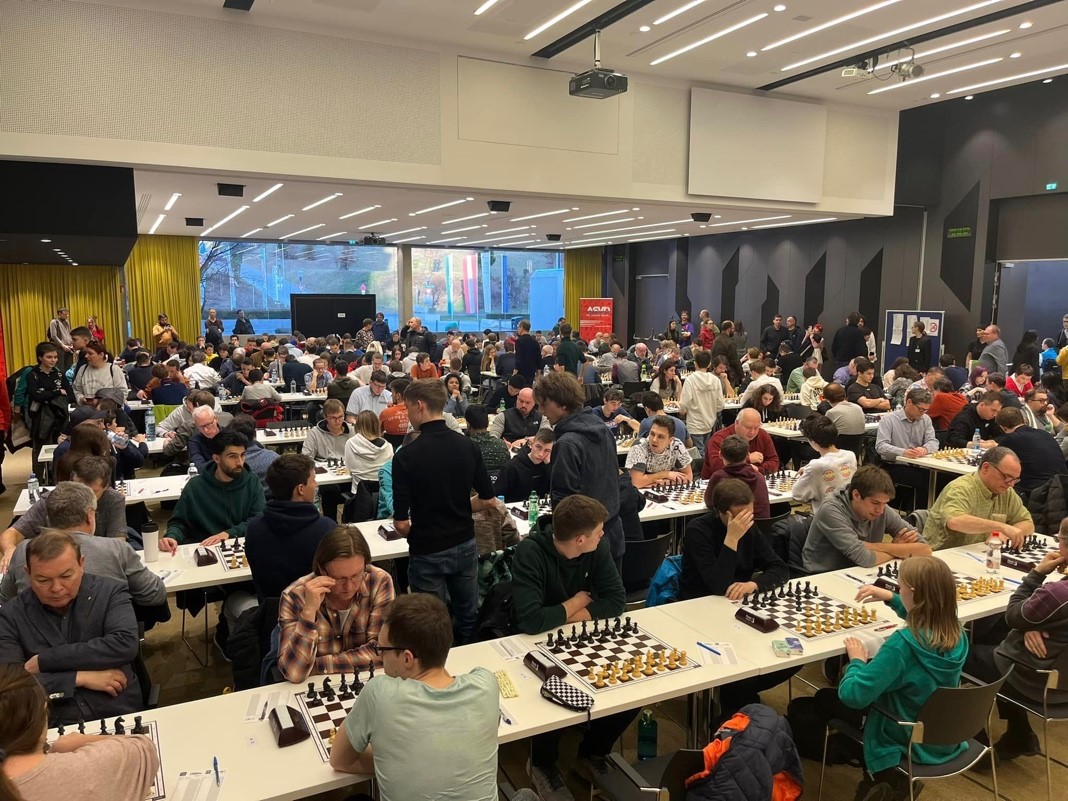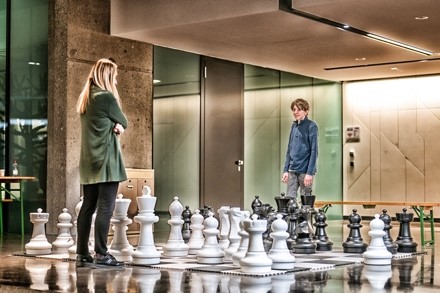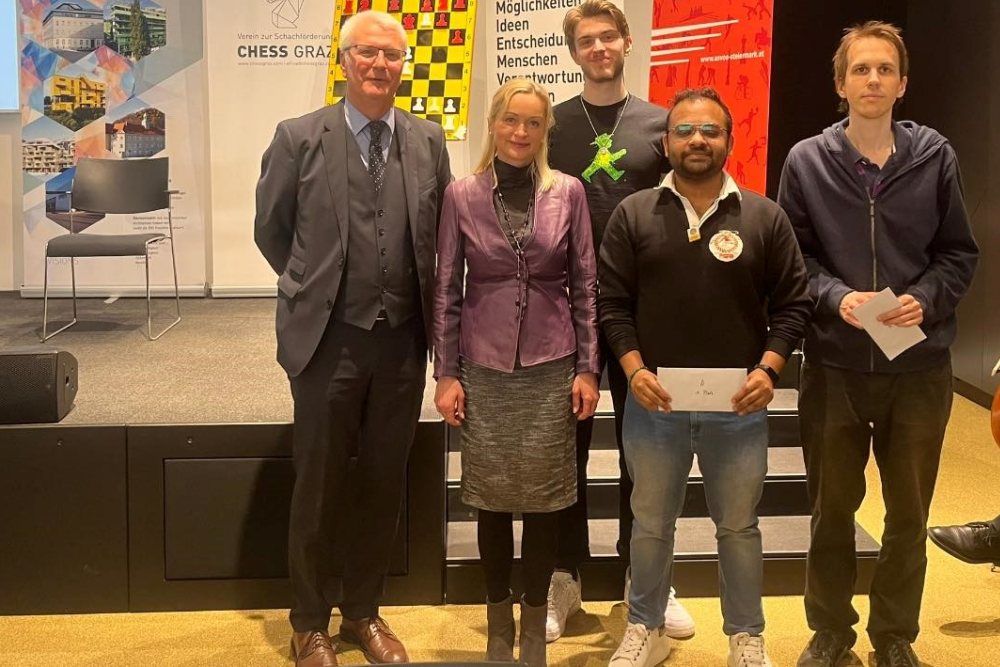Austria’s largest tournament
Press release
In the week from February 18 to February 24, the Europasaal of the Graz Chamber of Commerce became the venue of the 29th International Graz Open.

A total of 370 participants from 37 nations all over the world took part. The winners were determined after 9 rounds. Since the tournament was open to all players, everyone could participate. Professionals (9 grandmasters) and newcomers were present — the youngest 5 years old, the oldest 85 years old.

When you entered the Chamber of Commerce or the WIFI this week, it was impossible to get past the topic of chess. In the foyer there was a garden chess set next to a number of boards, and in the restaurant analyses’ sessions were running constantly.
The tournament was held in four groups. In the A group, the strongest participated; in the B group, the club players; and in the C group, the newcomers to the sport. Weekend tournaments were held on the first three days and were open to all.
 The aim of this course is to help you understand how to make tactical opportunities arise as well as to sharpen your tactical vision - these selected lectures will help to foster your overall tactical understanding.
The aim of this course is to help you understand how to make tactical opportunities arise as well as to sharpen your tactical vision - these selected lectures will help to foster your overall tactical understanding.In the C group, the Austrians dominated. The winner of group B, Bochnickova Simona, coame from Slovakia. Second place went to Balaz Frantisek (Czechia), and third place went to Kudlak Julia (Poland).
The Styrian National Championship was also held in the A group. David Schernthaner can call himself Styrian National Champion, ahead of Daniel Kristoferitsch, who was the runner-up.
The victory of the A-tournament and thus the overall victory went to India. Grandmaster Abhijeet Gupta dominated with a convincing performance of 8 points in 9 games.
Runner-up was GM Hagen Pötsch, who scored 7 points and tied for third and fourth place. The tiebreak criteria gave third place to Austrian Grandmaster Felix Blohberger.
The venue turned out to be perfect for this tournament. The size and tranquillity are ideal, the public transport connections are good and there are plenty of parking spaces available. The social programme included a free guided tour of the city, and the mayor of Graz welcomed the participants in the town hall.
Mario Schachinger annotated two games played by the winner of the event:
Select an entry from the list to switch between games
Final standings - Group A
| 1 |
2 |
|
GM |
Gupta Abhijeet |
|
|
2606 |
8 |
2696 |
2696 |
10 |
10 |
| 2 |
6 |
|
GM |
Pötsch Hagen |
|
|
2489 |
7 |
2578 |
2578 |
10 |
10,4 |
| 3 |
7 |
|
GM |
Blohberger Felix |
|
|
2488 |
7 |
2533 |
2533 |
10 |
5,4 |
| 4 |
18 |
|
IM |
Dobrowolski Piotr |
|
|
2411 |
7 |
2471 |
2471 |
10 |
6,8 |
| 5 |
3 |
|
GM |
Moroni Luca Jr |
|
|
2576 |
6,5 |
2571 |
2571 |
10 |
2,2 |
| 6 |
8 |
|
IM |
Janzelj Tim |
|
|
2469 |
6,5 |
2482 |
2482 |
10 |
2,9 |
| 7 |
21 |
|
FM |
Pastar Slaven |
|
|
2376 |
6,5 |
2477 |
2477 |
20 |
25 |
| 8 |
13 |
|
IM |
Hacker Jonas |
|
|
2444 |
6,5 |
2455 |
2455 |
10 |
4 |
| 9 |
25 |
|
FM |
Carnicelli Valerio |
|
|
2351 |
6,5 |
2392 |
2392 |
20 |
12,2 |
| 10 |
5 |
|
IM |
Roshka Yevgeniy |
|
|
2503 |
6,5 |
2385 |
2385 |
10 |
-7 |
| 11 |
1 |
|
GM |
Socko Bartosz |
|
|
2624 |
6 |
2480 |
2480 |
10 |
-11,7 |
| 12 |
24 |
|
IM |
Kowalski Igor |
|
|
2357 |
6 |
2445 |
2445 |
20 |
23,2 |
| 13 |
26 |
|
FM |
Wilhelm Till |
|
|
2350 |
6 |
2443 |
2443 |
20 |
22,8 |
| 14 |
16 |
|
IM |
Barp Alberto |
|
|
2429 |
6 |
2438 |
2438 |
10 |
2 |
| 15 |
28 |
|
IM |
Battey Alexander |
|
|
2344 |
6 |
2403 |
2403 |
10 |
7,8 |
| 16 |
69 |
|
|
Delgerdalai Bayarjavkhlan |
U14 |
|
2189 |
6 |
2402 |
2402 |
40 |
87,2 |
| 17 |
10 |
|
GM |
Socko Monika |
|
w |
2450 |
6 |
2387 |
2387 |
10 |
-6,2 |
| 18 |
12 |
|
IM |
Rosner Jonas |
|
|
2447 |
6 |
2377 |
2377 |
10 |
-7 |
| 19 |
9 |
|
GM |
Diermair Andreas |
|
|
2457 |
6 |
2373 |
2373 |
10 |
-8,3 |
| 20 |
36 |
|
FM |
Bochnicka Vladimir |
U18 |
|
2300 |
6 |
2339 |
2339 |
20 |
9,4 |
| 21 |
19 |
|
FM |
Tisaj Domen |
|
|
2396 |
6 |
2331 |
2331 |
20 |
-11,4 |
| 22 |
54 |
|
|
Schimnatkowski Lukas |
|
|
2220 |
6 |
2323 |
2323 |
20 |
25,2 |
| 23 |
17 |
|
IM |
Gschnitzer Adrian |
|
|
2428 |
6 |
2306 |
2306 |
10 |
-10,7 |
| 24 |
40 |
|
FM |
Gschiel Alexander |
U18 |
|
2288 |
6 |
2293 |
2293 |
20 |
3,6 |
| 25 |
11 |
|
GM |
Petursson Margeir |
|
|
2448 |
6 |
2291 |
2291 |
10 |
-14,5 |
...171 players
Enjoy Capablanca's fine technique, Tal's magic, Lasker's fighting spirit, Petrosian's defensive skills, Smyslov's feeling for harmony, and Alekhine's and Spassky's flair for the attack.
Links

























